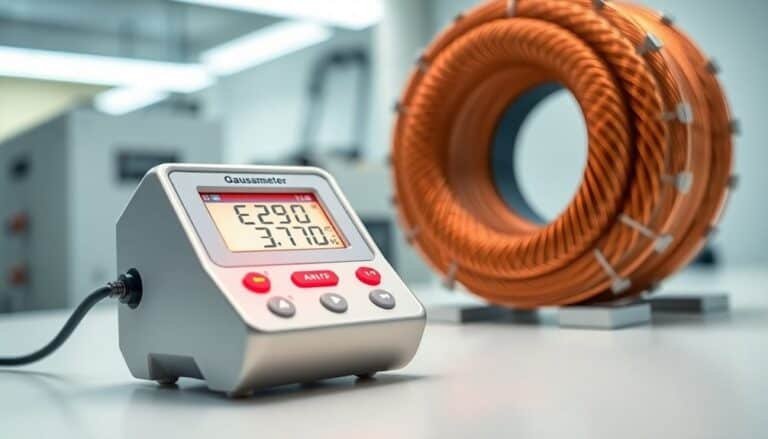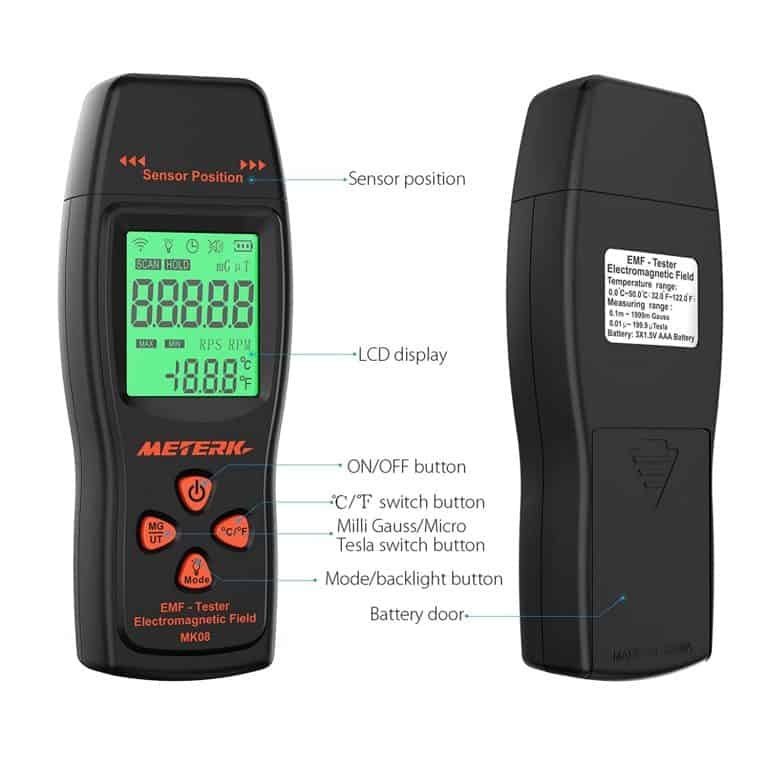How to Measure EMF From Power Lines

To measure EMF from power lines, use a gaussmeter to record magnetic fields in gauss or milligauss at various distances, noting that field strength decreases with distance. For greater accuracy, employ a 3-axis meter and take readings from different angles.
Capture multiple readings over time to account for variations due to electrical usage, while ensuring adherence to safety guidelines to reduce risks. Additional methods and considerations can enhance the thoroughness of your assessment.
Disclaimer: As an affiliate, I may collect a share of sales from the links on this page.
Understanding EMF and Its Sources
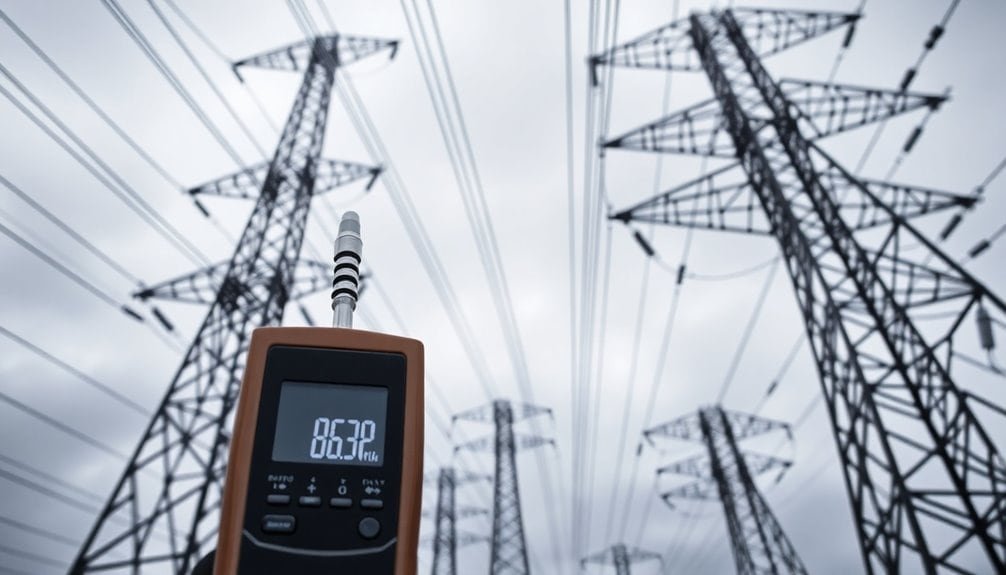
Electric and magnetic fields, collectively known as EMFs, are essential components of our electrical environment. EMFs are invisible energy areas arising from electric power use. Common sources include electric power lines, electrical wiring, home appliances, and electric tools.
Two main types exist: electric fields and magnetic fields, each with unique causes and effects. For instance, electric fields typically emerge from charged surfaces, while magnetic fields are generated when current flows through conductors. Understanding these sources helps you recognize EMF’s presence in your surroundings, which can fluctuate based on distance, current, and environmental factors, raising health concerns in long-term exposure studies. Notably, the magnetic field under high-voltage overhead power lines can reach levels of 5 – 10 µT, which is considerably higher than those from lower-voltage lines. Long-term exposure to these higher levels may lead to significant health risks.
Importance of Measuring EMF
Measuring electromagnetic fields (EMF) is vital for several reasons, mainly because it helps identify exposure levels and assess potential health risks.
You need to understand that proximity to power lines greatly affects your exposure more than voltage alone. Field strength decreases with distance, meaning measurements inform you about safe distances. Research links prolonged magnetic field exposure to possible health issues, particularly in children, so collecting data is essential. Accurate measurements guarantee compliance with safety standards, guiding community planning and real estate decisions. The strength of EMF from electricity decreases with distance, reinforcing the importance of monitoring exposure levels. Additionally, understanding safe distances from mobile towers can help in making informed decisions about living environments near power lines.
Transparency fosters public reassurance, reducing anxiety while underscoring the need for informed decision-making in your environment.
Types of EMF Measurement Devices
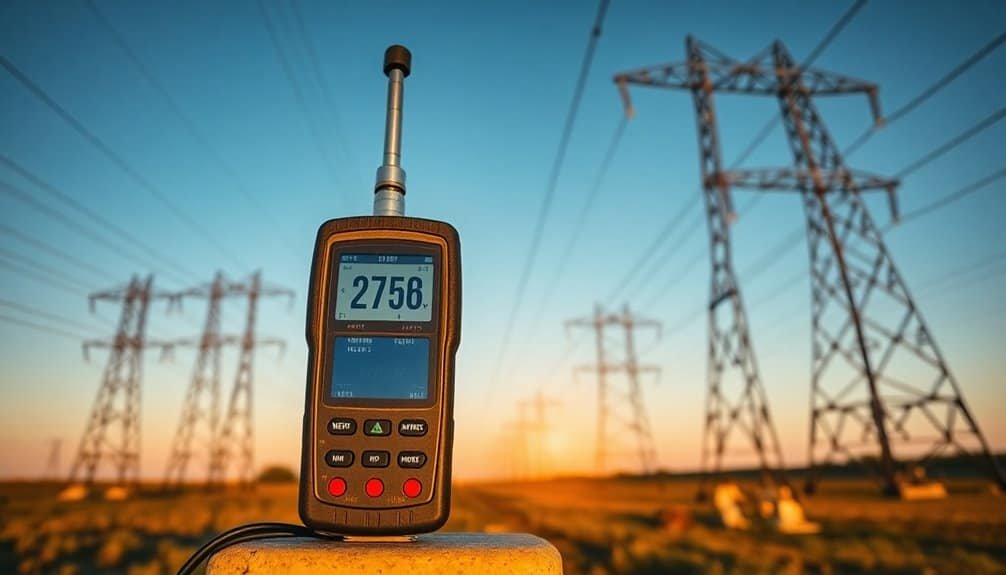
A variety of devices exist to measure electromagnetic fields (EMFs) generated by power lines and other sources. These tools help you assess EMF exposure in different environments. Here are three common types:
- Gaussmeters: Measure magnetic fields, typically in gauss or milligauss. These devices are crucial because they can quantify magnetic fields created by the flow of electricity.
- Power Density Meters: Detect the intensity of radiofrequency radiation.
- TriField Line EMI Meter: Specializes in measuring electromagnetic interference in AC power lines.
How to Use a Gaussmeter
Using a gaussmeter effectively involves a clear understanding of its operation and usage, ensuring accurate measurements of electromagnetic fields.
First, select a multi-axis gaussmeter to capture field strength in all directions. Position the device near power lines or in frequently occupied areas.
When measuring, take readings at various distances and times to observe changes in EMF levels. Make sure your gaussmeter can measure frequencies between 50-60 Hz, typical for power lines.
Always check for a clear display and good sensitivity. Repeat measurements for reliability.
Your efforts will yield valuable insights into EMF exposure in your environment.
Measurement Techniques for Accurate Readings
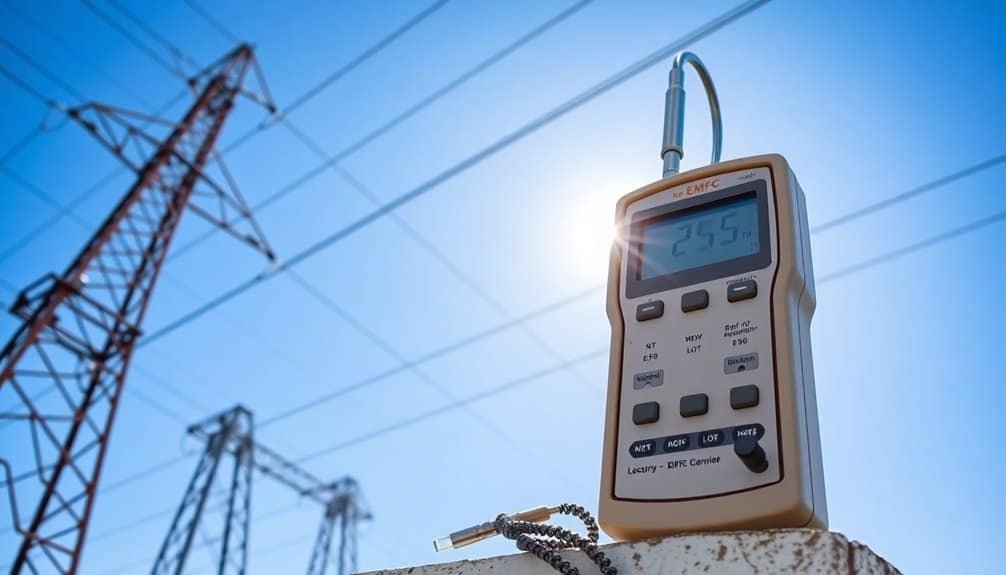
When seeking accurate electromagnetic field (EMF) measurements, employing multiple techniques is crucial. This approach guarantees reliability in your readings.
- Conduct multiple time measurements to capture variations in electrical usage throughout the day.
- Measure at varying distances from power lines, observing how EMF strength diminishes with distance.
- Use angled measurements with a 3-axis device, allowing for a more thorough capture of EMF readings from different perspectives.
Incorporating these techniques can considerably enhance the accuracy of your EMF assessments, providing a better understanding of the environmental conditions around power lines. Additionally, it’s important to consider the types of EMF radiation present, as they can influence your readings and overall assessment of exposure.
Factors Affecting EMF Strength
Understanding the factors that influence electromagnetic field (EMF) strength helps you assess potential exposure risks effectively. Key factors include current flow, distance, line configuration, voltage, frequency, and environmental conditions.
The magnetic field strength is directly proportional to current; higher current results in stronger fields. EMF decreases rapidly with distance from power lines, where proximity dramatically affects exposure.
Configuration, such as wire arrangement, alters field strength and patterns. While voltage influences electric fields, it doesn’t impact magnetic fields directly.
Finally, changes in demand, seasonal usage, and weather can affect current flow, thereby varying EMF levels over time.
Health and Safety Guidelines
To guarantee your safety from EMF exposure, regulatory agencies establish strict guidelines based on extensive research. These guidelines, set by organizations like ICNIRP and IEEE, aim to prevent biological responses from high exposure.
Consider these key points:
- Exposure Limits: Strict exposure limits prevent immediate health effects, like visual or skin sensations.
- Distance Matters: Increasing your distance from power lines effectively reduces EMF exposure.
- No Direct Link: Research shows no established connection between low-level EMF exposure and adverse health effects.
Following these guidelines ascertains your safety and well-being in relation to EMF exposure.
Environmental Considerations
Environmental considerations play a significant role in evaluating the impact of power lines on both human health and ecosystems. High-voltage power lines generate significant electromagnetic fields (EMFs), which decrease with distance.
While EMFs naturally occur, studies assess their effects on wildlife populations and local habitats. Regulations focus on minimizing ecological disruption caused by power infrastructure, with programs like California’s EMF initiative conducting essential impact assessments.
Implementing shielding technologies and optimizing power line designs can mitigate EMF emissions. Shifting to renewable energy sources also promises to reduce reliance on these structures, promoting a healthier environment for both communities and ecosystems.
Economic Implications of EMF Assessment
When evaluating electromagnetic fields (EMFs) from power lines, the financial aspects are essential to take into account.
Consider these key implications:
- Mitigation Costs: Implementing methods like cancellation wires incurs significant expenses that affect project budgets.
- Regulatory Compliance: Meeting EMF regulations necessitates thorough assessments and infrastructure adjustments, adding to costs.
- Public Perception: Widespread concerns about health risks can increase demand for costly mitigation measures, affecting overall project economics.
Understanding these factors helps in making informed decisions about EMF assessments, ensuring financial viability while maintaining public safety and infrastructure integrity.
Frequently Asked Questions
Can EMF Measurements Vary by Time of Day?
Yes, EMF measurements can vary by time of day. You’re likely to notice fluctuations from increased electricity usage during peak hours, impacting the strength of the electromagnetic fields around you. Take measurements consistently for reliable results.
How Can I Interpret EMF Measurement Results?
Have you wondered what those EMF measurement results really mean? To interpret them effectively, compare your readings to established safety limits, assess power density, and consider both electric and magnetic field contributions for a thorough understanding.
Is There a Safe Threshold for EMF Exposure?
There’s no universally accepted safe threshold for EMF exposure, as guidelines vary widely. You should distance yourself from sources like power lines whenever possible to minimize exposure and stay informed about local regulations and recommendations.
Do EMF Shields Effectively Reduce Exposure?
Imagine wrapping yourself in a protective cocoon, shielding against invisible forces. EMF shields can reduce exposure, but their effectiveness varies by material and frequency. You’ll need to choose wisely to guarantee maximum protection.
What Are the Long-Term Health Effects of EMF Exposure?
You’ve likely heard about various concerns regarding long-term EMF exposure. While some studies suggest links to health issues, experts generally assert that safety levels are maintained, and more research is needed to draw definitive conclusions.
Conclusion
Measuring EMF from power lines is essential for understanding your surroundings. Using devices like gaussmeters ensures accurate readings, while factors like distance and line voltage can affect results. Prioritize health guidelines and consider economic impacts to make informed decisions about exposure, contributing to a safer living space.



